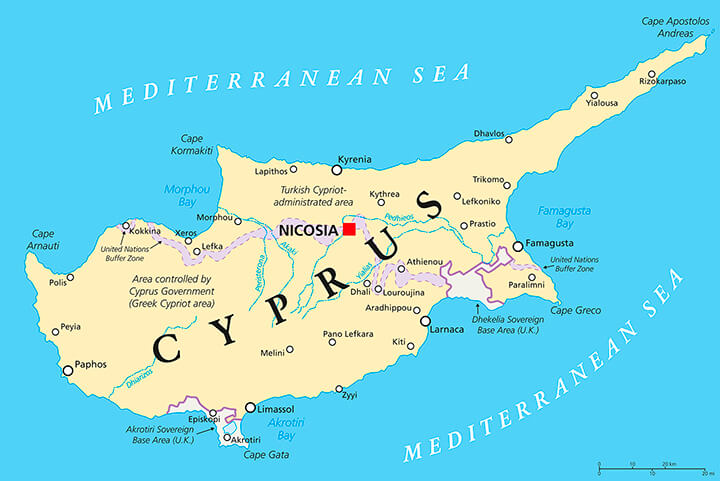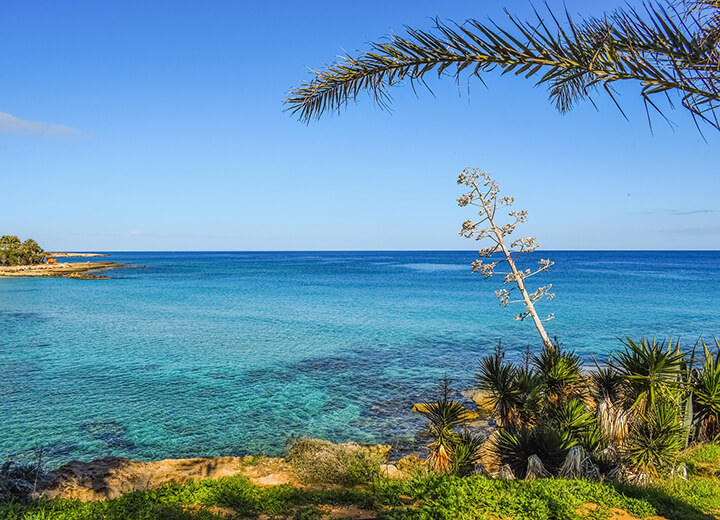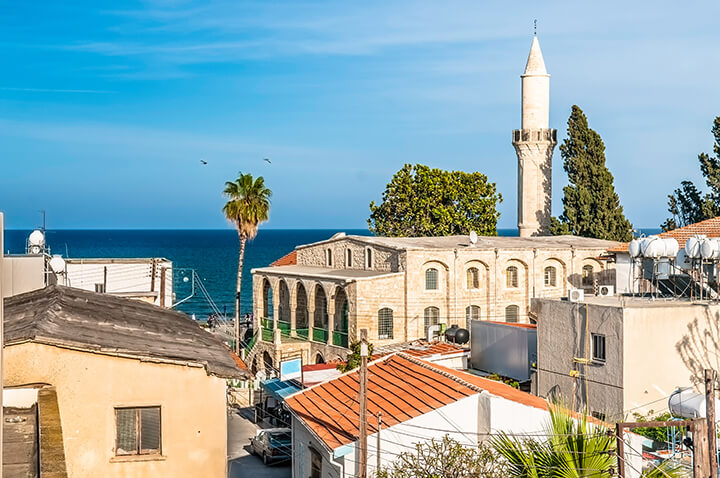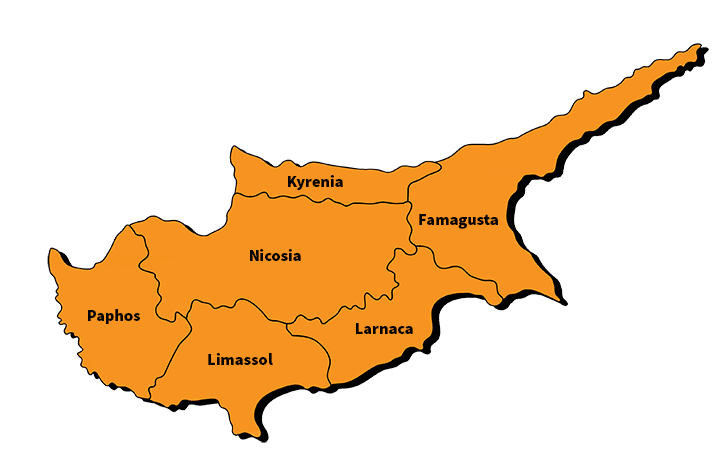Situated in the eastern basin of the Mediterranean Sea is the beautiful island of Cyprus. It is the third largest island in the Mediterranean, measuring 240 km in length, and 100 km in width.
Where is Cyprus Located?
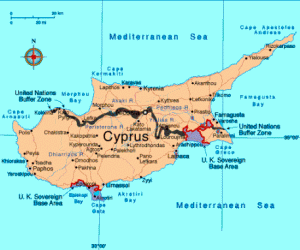 Due to its geographic location, Cyprus can be included in the Middle East, Western Asia, or Europe. Turkey is 75 km to the north. Syria is 105 km to the east. Lebanon is 108 km to the east. Israel is 200 km to the southeast. Egypt is 380 km to the south.
Due to its geographic location, Cyprus can be included in the Middle East, Western Asia, or Europe. Turkey is 75 km to the north. Syria is 105 km to the east. Lebanon is 108 km to the east. Israel is 200 km to the southeast. Egypt is 380 km to the south.
The Greek mainland is 800 km to the west-northwest: Rhodes is 400 km away, and it is 280 km from Cyprus to the small Dodecanese island of Kastellórizo (Meyísti).
Mountains & Physical Features
Mountain masses and the central plain they encompass, the Mesaoria, dominate Cyprus’ physical setting.
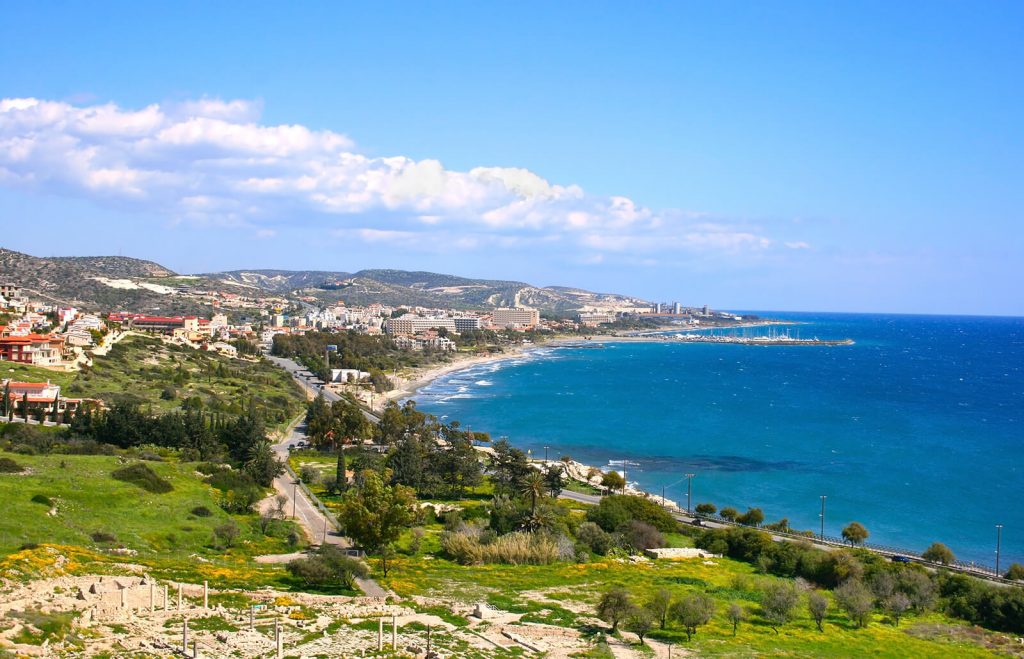 The island has multiple mountain chains and large interior plains as well as 648km of coastline.
The island has multiple mountain chains and large interior plains as well as 648km of coastline.
The Troodos Mountains cover most of the southern and western portions of the island and account for roughly half its area. The narrow Kyrenia Range, extending along the northern coastline, occupies a substantially less expanse and has lower elevations.
Coastal lowlands surround the island with varying widths.
Plains
The Mesaoria (meaning between the mountains) is a sweeping plain that makes up the center of the island. The Mesaoria plain is bounded on the east and west by the Mediterranean Sea, on the south by the Troodos mountains. To its north lie the Kyrenia mountains.
It has an area of approximately 1000 square km. It rises to an altitude of 325 meters, with an average elevation of around 100 meters.
There are many rivers and other watercourses crossing this plain, but none of them have water all year round.
The Mesaoria is the most settled region on the island, containing dozens of villages and many of the most significant towns, including the capital, Nicosia.
Trodos Mountains
The Troodos mountain range is the most prominent mountain range of Cyprus, located in the center of the island; it stretches across most of the western side of Cyprus.
Its highest peak is Mount Olympus at 1,952 meters. The area has been known since ancient times for its copper mines, and in the Byzantine period it became a renowned center of Byzantine art, as churches and monasteries were built in the mountains, away from the threatened coastline, and they still exist today.
Kyrenia Mountains
The Kyrenia mountain range is a long, narrow chain of mountains that runs approximately 160 km along the north coast of Cyprus. The collective chain is also known as the Pentadactylos.
The mountains are primarily limestone, with some marble. The highest peak, Kyparissovouno is 1,024 meters in elevation. The western half of the range is known as the Pentadactylos (five fingers) mountains.
Though only half the height of the Troodos mountains, the Kyrenia mountains are very rugged. These peaks rise abruptly from the Mesaoria plain making them a spectacular sight.
Plant Variety
The Cyprus Mediterranean Forests ecoregion encompasses the high and steep Troodos massif and hills and low plains of the island, which hosts a wide range of habitats. With approximately 1,800 species and subspecies of flowering plants, Cyprus is a botanist’s paradise.
Oak, strawberry, juniper, and cypress trees thrive at lower elevations, while the driest level plains in the center host semi-arid, shrub-like vegetation and wild olive trees, and carob trees.
In the medium elevations, pine forests are wide-spread and endemic evergreen oak forests.
Pine forests and juniper woodlands cover the higher elevations of the mountains which provide an ideal habitat for many specialized species of plants and animals.
Abundant and Unique Wildlife
Each mountain range hosts some plants and animals that are found nowhere else on earth. One such creature is the Cyprus mouflon, also called Agrino from Greek Αγρινό. Although few, they still survive in the mountains of the protected reserve of the Paphos Forest Station.
The Cyprus mouflon is a reclusive, indigenous rare type of wild mountain sheep, and is a protected species. The sheep is also a national symbol, displayed on some of the Cyprus euro coins and Cyprus stamps, and was also the emblem of the former national airline.
Birds
Cyprus is also a major bird migration route, with it being on a north-south migration route. Thousands of birds every year transit via Cyprus, some in vast flocks and some in small clusters.
The resting period of each type of bird varies, with some only resting for a few days to a week, and others for several weeks or months. The Northward migration period is from March to May, while the Southward migration period is from August to October.
The most popular of the migrating birds are the pink flamingos that flock every year to the Larnaca salt lake for the winter months. People come from far and wide to take in the spectacular view of the beautiful pink flamingos, which migrate in their thousands annually.
More recently, the Greater flamingo has also been seen. With over 360 different species of birds documented on the island, many of them migratory, Cyprus is a perfect haven for bird watchers.
